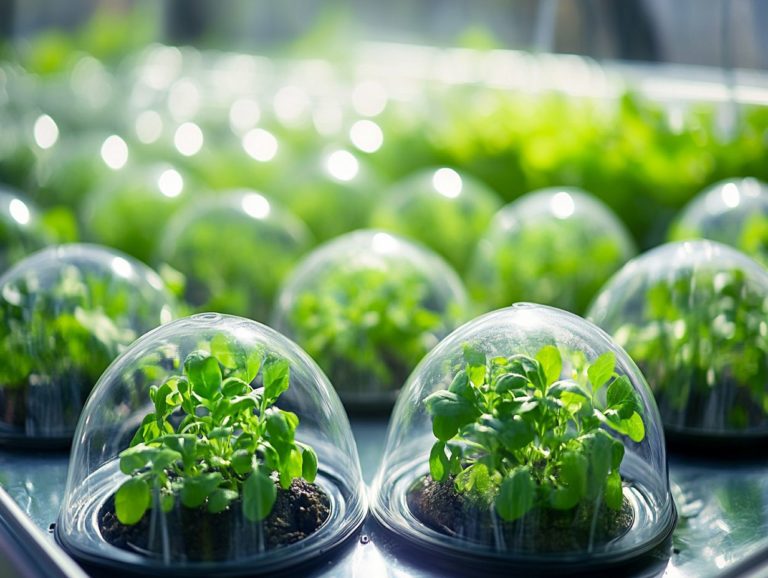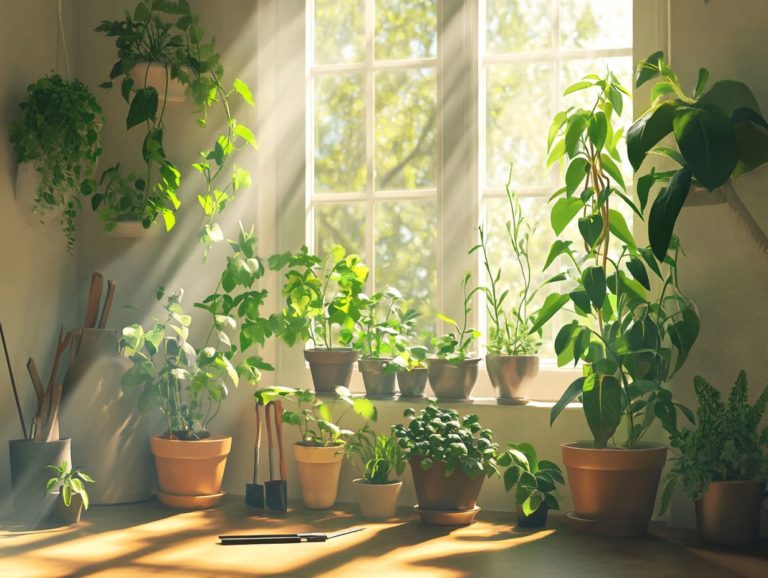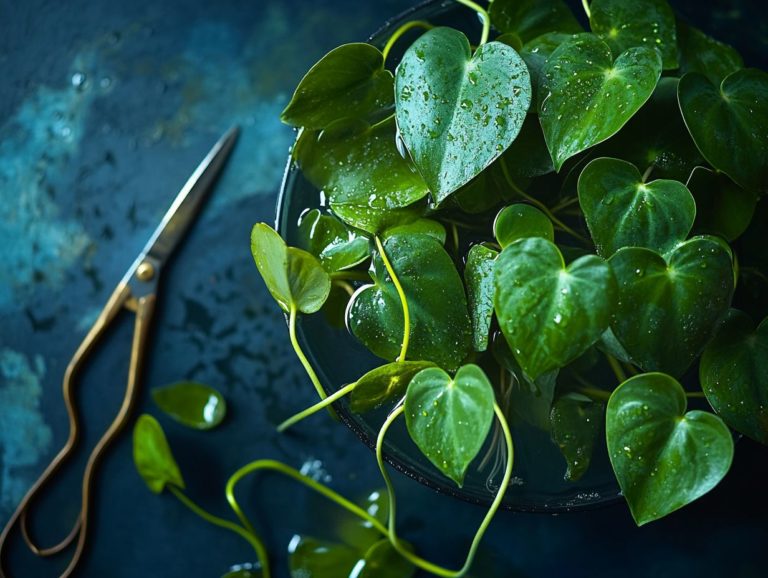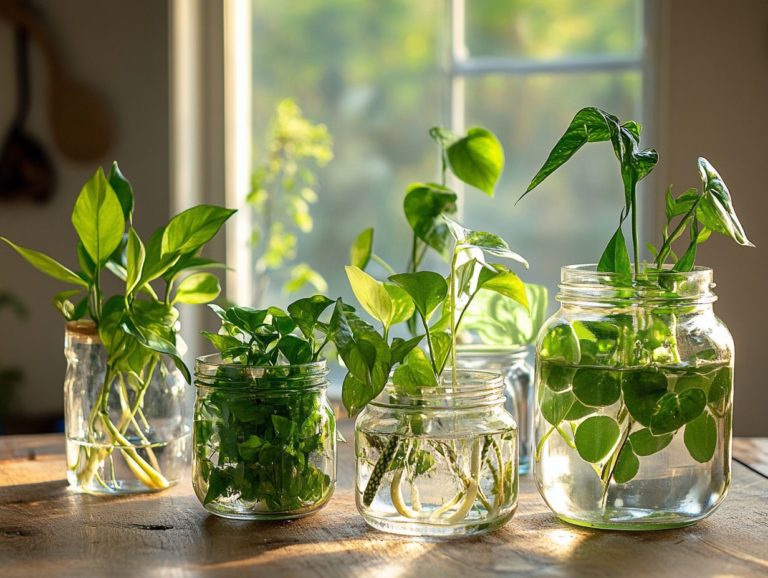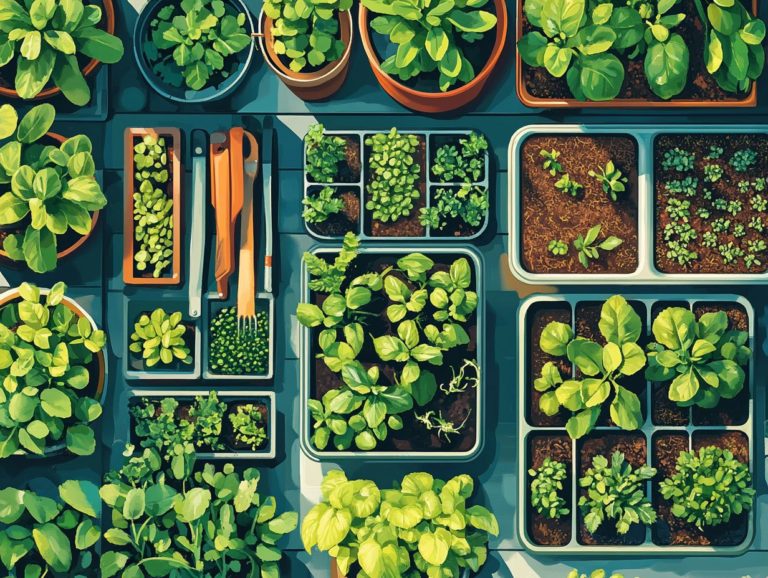The Tools You Need for Plant Propagation
If you’re keen on expanding your garden or cultivating new plant life, mastering propagation techniques is not just a task it s an exhilarating journey filled with rewards.
This guide delves into a variety of methods, from seed propagation to cuttings, division, layering, grafting, and budding. You ll discover essential tools designed to elevate your success rate.
Whether you re just starting out or have years of gardening experience under your belt, you ll uncover valuable insights that will empower your plants to flourish.
Contents
- Key Takeaways:
- 1. Propagation by Seed
- 2. Propagation by Cuttings
- 3. Propagation by Division
- 4. Propagation by Layering
- 5. Propagation by Grafting
- 6. Propagation by Budding
- 7. Choosing the Right Tools for Growing New Plants
- 8. Pruning Shears
- 9. Rooting Hormone
- 10. Seed Trays or Pots
- 11. Heat Mat
- 12. Plant Labels
- 13. Potting Soil
- 14. Mist Sprayer
- 15. Propagation Dome or Plastic Bag
- Frequently Asked Questions
- What are the essential tools for plant propagation?
- Do I need to use rooting hormone for plant propagation?
- What type of pruning shears should I use for plant propagation?
- Can I use any soil for plant propagation?
- What is the purpose of a spray bottle in plant propagation?
- Are there any alternative tools I can use for plant propagation?
Key Takeaways:
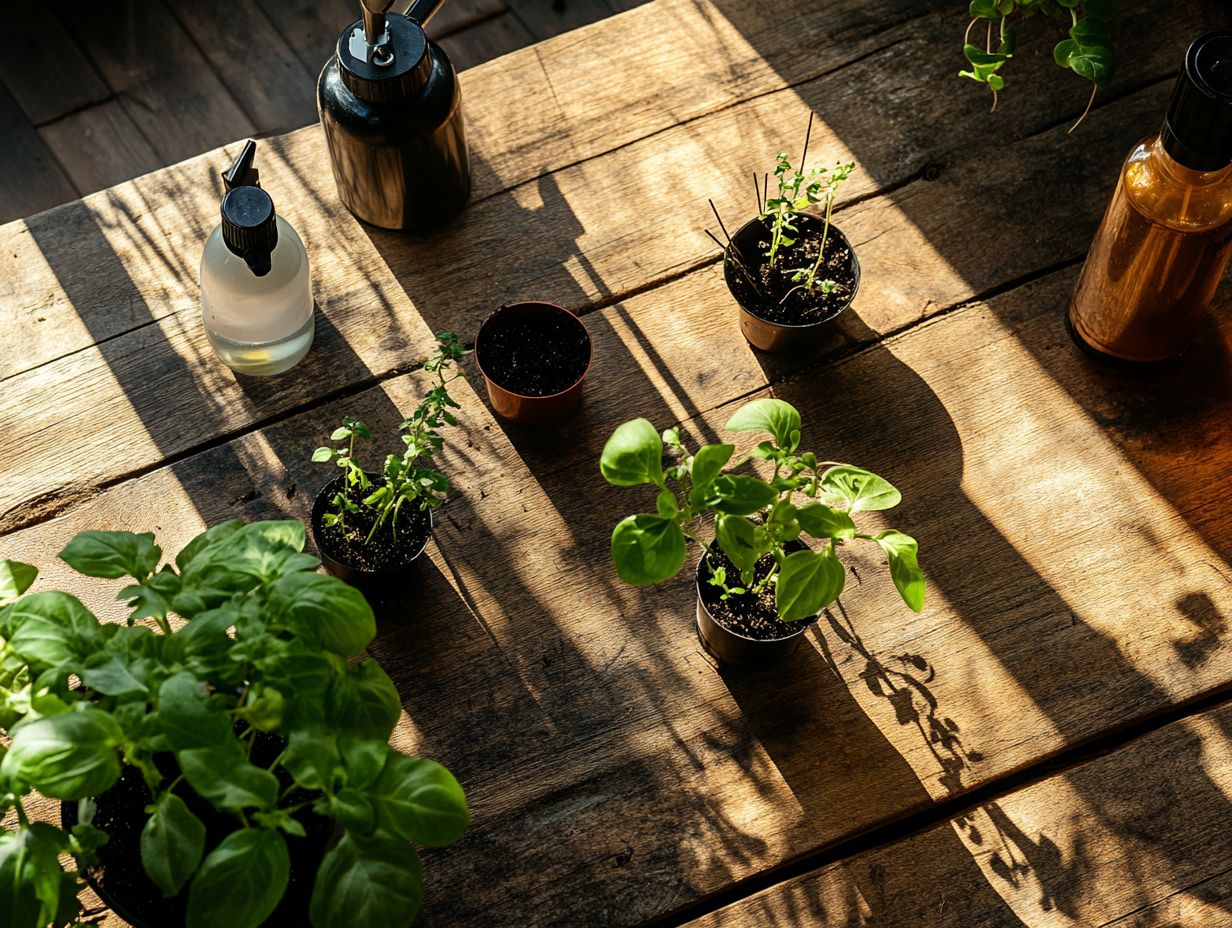
- Choose the right tools for successful plant propagation.
- Essential tools include pruning shears, rooting hormone, seed trays or pots, heat mat, plant labels, potting soil, mist sprayer, and propagation dome or plastic bag.
- Different propagation methods require specific tools for best results.
1. Propagation by Seed
Propagation by seed is a fun and rewarding way to grow your favorite plants! By using various growing mediums and soil additives, you can achieve optimal results. This method offers a gratifying experience and deepens your understanding of plant biology.
Choosing the right seeds is crucial, as it significantly influences your germination success rate. Once you ve made your selection, prepare your seed trays by ensuring they are clean and free from contaminants.
Opt for high-quality potting soil to retain moisture and supply essential nutrients. Consider adding soil additives that help with drainage and air circulation to improve aeration.
Light is essential during germination; placing your trays in a bright area or under grow lights will help your seedlings grow strong and healthy.
This comprehensive approach to seed propagation promotes successful growth and enriches your connection to the plants you nurture.
2. Propagation by Cuttings
Propagation by cuttings is a highly effective method that allows you to clone your favorite plants. You can nurture cuttings until they develop roots and transform into new, independent specimens.
You can utilize various types of cuttings stem, leaf, or root each with its unique advantages. For instance, stem cuttings work exceptionally well for many houseplants, while leaf cuttings can produce vibrant new plants, like succulents. Though less common, root cuttings can be a viable option for some perennials.
Many gardeners use rooting powder, which contains hormones that stimulate growth, to promote robust root development. Mist systems can help maintain necessary humidity levels, ensuring your cuttings stay hydrated.
When selecting containers, ensure they have adequate drainage. Monitor light exposure; too much sunlight can stunt growth, while too little can slow it down.
3. Propagation by Division
Propagation by division is an elegant and effective technique often used for perennials. It enables you to separate established plants into multiple thriving sections or clumps.
To start the division process, select robust and mature plants that show signs of overcrowding or a decline in flowering. Ideal candidates typically include hostas, daylilies, and irises, as they adapt well to being divided.
Use a well-draining soil mixture, aiming for a blend of equal parts garden soil, compost, and perlite to foster healthy root growth.
Timing is crucial; early spring or fall are prime seasons for division, allowing plants to establish their roots before extreme temperatures arrive.
After transplanting, consistent watering and a balanced fertilizer will significantly enhance recovery and promote vigorous growth in their new environments.
4. Propagation by Layering
Propagation by layering is a natural technique to encourage new roots to form on a stem while it remains attached to the parent plant. This makes it an effective strategy for propagating certain types of plants with minimal intervention.
This method is particularly advantageous if you’re looking to cultivate woody shrubs or climbing vines, where traditional propagation methods can be tricky.
Among the various layering techniques, air layering involves wrapping a section of bark with moist material to promote root growth. Alternatively, serpentine layering allows a stem to bend into the soil at different points, creating multiple new plants from a single parent.
Selecting the right plants is crucial for success. Softwood plants often yield the best results. Using rooting hormone can significantly boost root development. Don’t forget about plant supports to keep those layered branches stable during the rooting phase.
Paying attention to these details will make your propagation process a triumph!
5. Propagation by Grafting
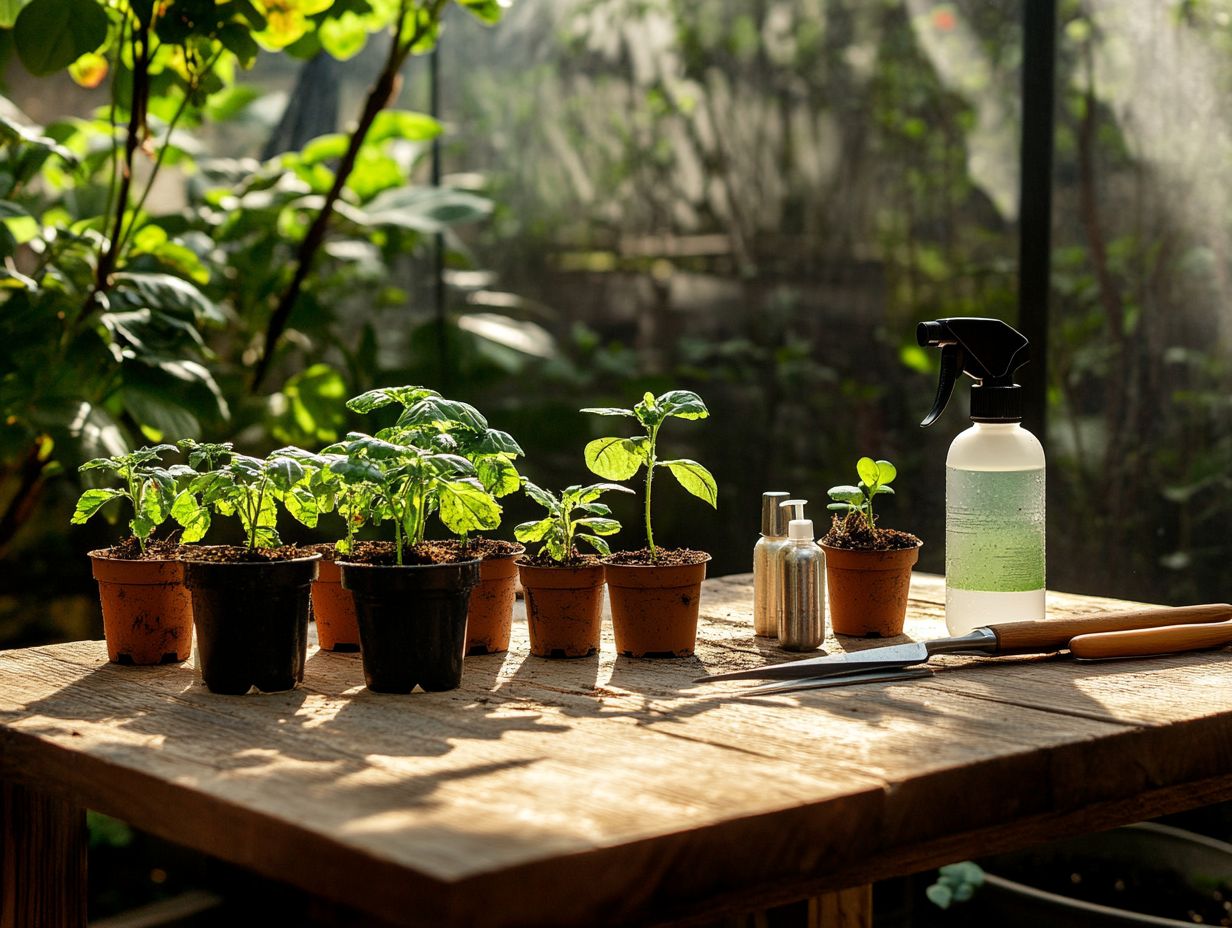
Propagation by grafting is a complex gardening method that allows you to combine the best traits of two plants. This creates a new hybrid with desirable characteristics like disease resistance or superior fruit quality. Skillful handling and the right cutting tools are essential for success.
Begin by selecting a scion, which is the part of the plant you want to grow for its exceptional qualities. You will join it with a stock or root system that nourishes it. Among the various grafting techniques, whip and tongue grafting deserves special mention for creating strong unions through interlocking cuts that facilitate healing.
The key to successful grafting lies in selecting compatible plant species. Mismatched combinations can lead to dismal outcomes. For those looking to enhance their propagation skills, knowing when to use soil for plant propagation is also essential. Essential tools for this process include:
- Sharp grafting knives for precise cuts
- Pruning shears for preparing the plants
Once you’ve completed the grafting, protect the graft site with grafting tape and ensure proper watering. This way, you can safeguard the connection as the two plant parts begin their journey of growth together.
6. Propagation by Budding
Propagation by budding is a refined technique of grafting that involves inserting a single bud from one plant into the stem of another. This method is efficient for fruit trees and ornamental plants.
This technique allows for the rapid multiplication of your chosen varieties and bolsters their resilience against diseases. Timing is critical! Make sure to bud during the plant’s active growth phase when sap is flowing freely, usually in late spring. The surrounding environment should feature mild temperatures and adequate moisture.
Among the various methods, T-budding and chip budding are commonly used. Each has unique procedural intricacies. To protect against disease transmission during this delicate process, use disinfectants on your tools to ensure the health of both the parent and rootstock plants is preserved.
7. Choosing the Right Tools for Growing New Plants
Selecting the right tools for growing new plants is essential for ensuring your plants thrive. Using high-quality cutting tools, such as pruning shears and propagation kits, can streamline your plant care and elevate the process, whether you’re a novice or a seasoned pro.
For the best results, gather some additional essentials: sturdy pots, a premium soil mix, and clear plastic bags to maintain humidity. These items foster growth and support the health of your cuttings during their critical early stages.
Consider incorporating optional tools like garden markers and labels to keep your setup organized. This way, you can easily track different plant species and their specific care requirements.
Don t underestimate the importance of regular tool maintenance. Cleaning your tools is vital to prevent disease spread. A simple soak in a diluted bleach solution can keep them hygienic and free from contaminants, ensuring a thriving garden for everyone involved.
8. Pruning Shears
Pruning shears are essential for all gardeners. They provide the precision needed for clean cuts, promoting healthy growth and preventing disease. Following proper disinfectant protocols is key.
You’ll find several types available: bypass shears, anvil shears, and ratchet shears. Each type is tailored for specific tasks. Bypass shears are best for cutting live stems and branches, while anvil shears are perfect for tackling tougher, dead wood. If you need extra leverage, ratchet shears make the tougher jobs easier on your hands.
When choosing the right pair, consider the thickness of the branches you plan to cut and how comfortable the shears feel in your hand during use. Regular cleaning with disinfectants is crucial to prevent cross-contamination between your plants. Don t forget that maintenance, like sharpening the blades, ensures your shears remain durable and perform well.
9. Rooting Hormone
Rooting hormone is an essential ally in your journey of growing new plants. It significantly boosts the success rate of your cuttings by stimulating root development and encouraging vigorous growth.
You ll find various types of rooting hormones, including powder, liquid, and gel. Each offers distinct advantages suited to different application methods and plant types.
To apply them effectively, simply dip the cut end of the stem into the hormone before placing it in your chosen growing medium. Pairing these hormones with suitable soil additives, like perlite (a lightweight aggregate) or vermiculite (a mineral that improves aeration), enhances aeration and drainage, fostering healthier root systems.
If you re interested in natural alternatives, consider using cinnamon or honey as effective rooting aids. Remember, maintaining optimal conditions adequate humidity, warmth, and indirect light is crucial for ensuring your cuttings root successfully.
10. Seed Trays or Pots
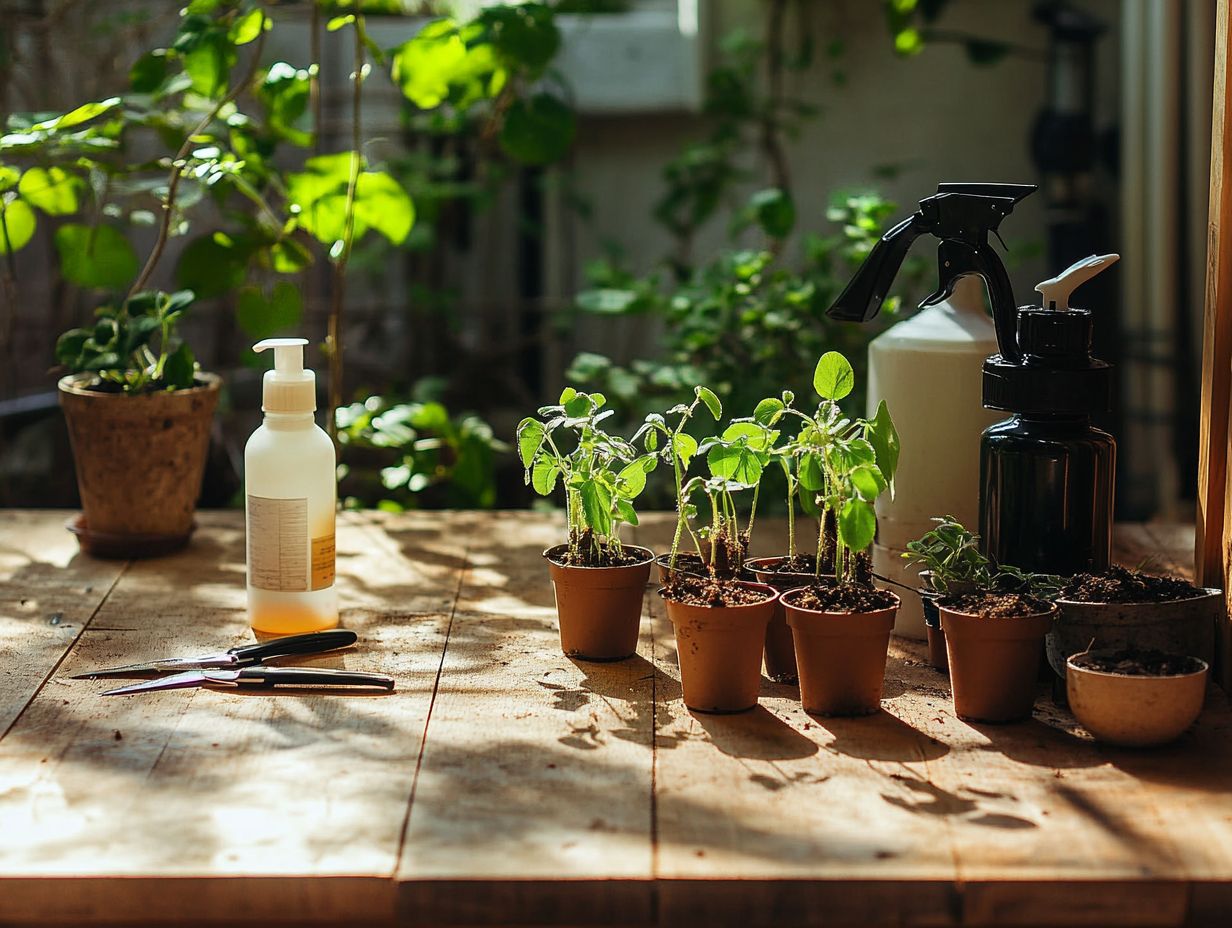
Selecting the right seed trays or pots is essential for your success in growing new plants. They allow for optimal drainage and air circulation when filled with the appropriate potting soil or growing mediums tailored to the unique needs of your seeds.
You’ll discover a variety of seed trays and pots made from materials such as plastic, biodegradable options, and terracotta. Each material offers distinct advantages. For instance, biodegradable pots are perfect if you’re environmentally conscious, as they break down naturally and promote root health. Sizes can vary dramatically, from small 12-cell trays that are just right for herbs to larger pots designed for vegetables.
When preparing your containers for planting, it s crucial to ensure they have drainage holes and are clean to ward off any potential diseases. Equally important is choosing your potting soil; specialized blends provide the necessary nutrients and structure to support vibrant growth and development of your seedlings.
11. Heat Mat
A heat mat is an invaluable tool for enhancing your germination process in propagation. It provides consistent warmth to your seeds and cuttings, promoting faster growth and healthier plants when paired with the right growing medium.
This temperature regulation is particularly beneficial for many plant species that thrive in warmer conditions, such as peppers, tomatoes, and certain herbs. By adjusting the heat level, you can create an optimal environment tailored to the specific needs of different seeds. For example, a setting of around 75-80 F is ideal for many vegetables, while others may prefer slightly higher temperatures.
Alongside managing heat, monitoring moisture levels is crucial; too much or too little can hinder seedling development. By implementing a heat mat and keeping a close eye on moisture, you ll set the stage for a thriving garden that flourishes with vitality.
12. Plant Labels
Plant labels are essential tools for any propagation project. They enable you to track plant varieties, sowing dates, and specific care instructions while instilling a sense of organization in your growing space.
You ll find these labels in various forms, from pre-made plastic stakes to wooden popsicle sticks, and even biodegradable options made from recycled materials. If you’re feeling creative, why not make your own labels? Old wine corks or stones can add a charming and personalized touch to your garden.
The importance of labeling cannot be overstated, especially during the propagation phase. It helps you avoid mix-ups that could lead to improper care, ensuring each plant receives the right amount of sunlight, water, and nutrients it needs.
By keeping your labels clear and organized, you can easily create a vibrant plant paradise, whether you re a novice or a seasoned gardener.
13. Potting Soil
Potting soil serves as the essential foundation for successful propagation. It is carefully made to deliver the nutrients, aeration, and drainage that your young plants need to flourish during their crucial early stages of growth.
This vital growing medium typically consists of a blend of components like peat moss, perlite, and vermiculite, each playing a key role in promoting optimal plant health. Peat moss is particularly good at retaining moisture while ensuring adequate air circulation, which is vital for young roots that can easily dry out. Perlite enhances drainage and aeration, preventing soil compaction that can suffocate delicate plants.
When selecting potting soil, consider the specific needs of different plant species you intend to cultivate. Some may thrive in moisture-retentive mixes, while others prefer well-drained environments. Customizing your soil mixtures based on your propagation methods whether using cuttings or seeds can significantly affect your success rates.
If you’re feeling adventurous, mixing your own can be quite rewarding. Combining compost with a base of peat and perlite is a highly effective strategy to meet those particular growing needs.
14. Mist Sprayer
A mist sprayer is an invaluable asset in your propagation toolkit. It expertly maintains consistent humidity levels for cuttings and seedlings, which is essential for preventing drying out and helping roots grow strong.
By creating a humid microenvironment, the misting system allows your plants to retain moisture without the risk of saturation, enhancing their overall health. This approach is versatile and can be seamlessly integrated into various propagation setups, from greenhouses to indoor gardens, making it adaptable for different scales of cultivation.
For best results, act quickly by establishing a misting schedule tailored to the specific needs of your plants, considering factors like temperature and species. Monitoring moisture levels with humidity sensors can provide critical insights, allowing you to adjust the misting frequency as needed. This ensures a balanced environment that promotes vigorous growth and thriving plants.
15. Propagation Dome or Plastic Bag
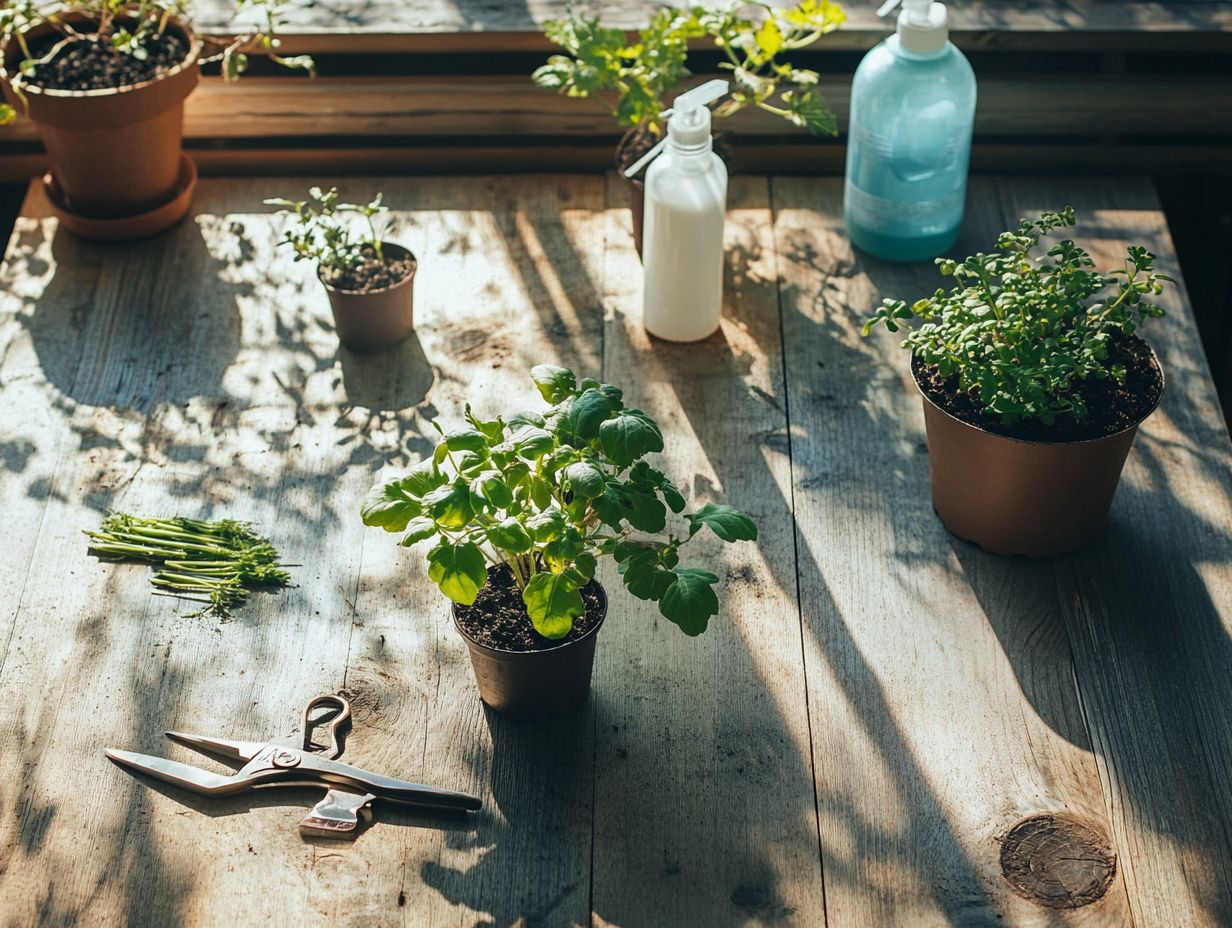
A propagation dome or plastic bag acts like a mini greenhouse. It traps warmth and humidity, giving your cuttings a better chance to root successfully.
This controlled environment provides ideal conditions for seedlings or cuttings. It minimizes transplant shock and encourages quicker establishment. For the best results, ensure proper ventilation; open the dome or bag slightly from time to time to prevent mold and avoid excessive moisture buildup.
Keeping an eye on moisture levels is crucial. The substrate should feel damp but never drenched.
Whether you’re nurturing delicate herbs or robust shrubs, these techniques create a cozy environment for your plants to thrive!
Frequently Asked Questions
What are the essential tools for plant propagation?
The essential tools for plant propagation include gardening gloves, pruning shears, rooting hormone, propagation trays, a spray bottle, and a soil medium.
Do I need to use rooting hormone for plant propagation?
While not necessary, using rooting hormone can increase the success rate of propagation by promoting root growth in the cutting.
What type of pruning shears should I use for plant propagation?
It is recommended to use a sharp, clean pair of bypass pruners for making clean cuts on plant cuttings.
Can I use any soil for plant propagation?
It is best to use a well-draining soil medium, such as a mixture of vermiculite and perlite, to prevent the cutting from sitting in water and rotting.
What is the purpose of a spray bottle in plant propagation?
A spray bottle is used to keep the soil medium and plant cuttings moist. They require a consistently moist environment to promote root growth.
Are there any alternative tools I can use for plant propagation?
While the tools mentioned are the most commonly used, you can also use a sharp knife instead of pruning shears and plastic bags in place of propagation trays.

